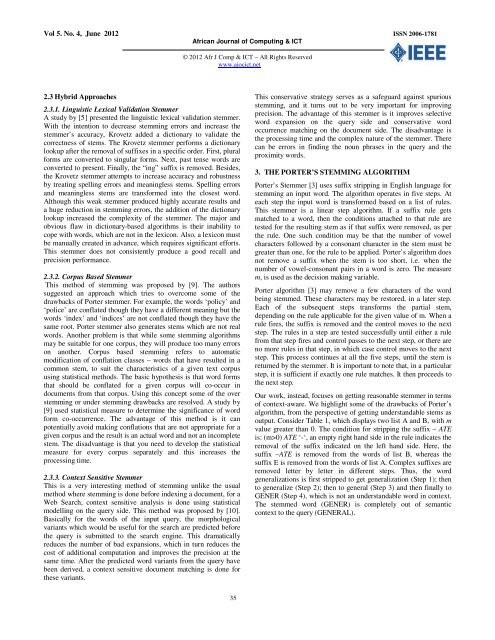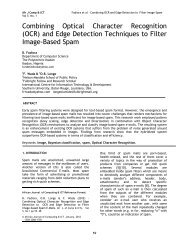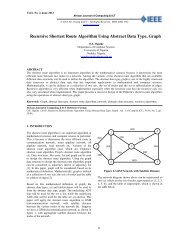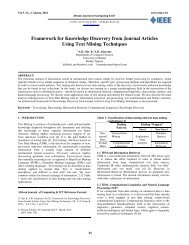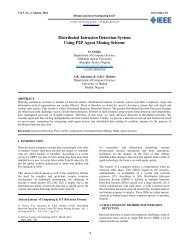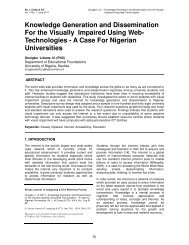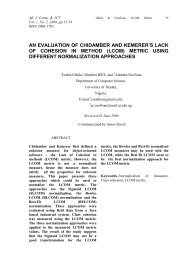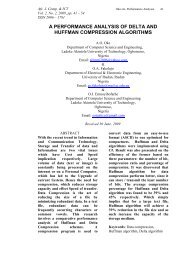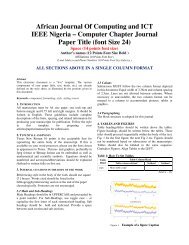Context-Aware Stemming Algorithm for Semantically Related Root ...
Context-Aware Stemming Algorithm for Semantically Related Root ...
Context-Aware Stemming Algorithm for Semantically Related Root ...
You also want an ePaper? Increase the reach of your titles
YUMPU automatically turns print PDFs into web optimized ePapers that Google loves.
Vol 5. No. 4, June 2012 ISSN 2006-1781African Journal of Computing & ICT© 2012 Afr J Comp & ICT – All Rights Reservedwww.ajocict.net2.3 Hybrid Approaches2.3.1. Linguistic Lexical Validation StemmerA study by [5] presented the linguistic lexical validation stemmer.With the intention to decrease stemming errors and increase thestemmer’s accuracy, Krovetz added a dictionary to validate thecorrectness of stems. The Krovetz stemmer per<strong>for</strong>ms a dictionarylookup after the removal of suffixes in a specific order. First, plural<strong>for</strong>ms are converted to singular <strong>for</strong>ms. Next, past tense words areconverted to present. Finally, the “ing” suffix is removed. Besides,the Krovetz stemmer attempts to increase accuracy and robustnessby treating spelling errors and meaningless stems. Spelling errorsand meaningless stems are trans<strong>for</strong>med into the closest word.Although this weak stemmer produced highly accurate results anda huge reduction in stemming errors, the addition of the dictionarylookup increased the complexity of the stemmer. The major andobvious flaw in dictionary-based algorithms is their inability tocope with words, which are not in the lexicon. Also, a lexicon mustbe manually created in advance, which requires significant ef<strong>for</strong>ts.This stemmer does not consistently produce a good recall andprecision per<strong>for</strong>mance.2.3.2. Corpus Based StemmerThis method of stemming was proposed by [9]. The authorssuggested an approach which tries to overcome some of thedrawbacks of Porter stemmer. For example, the words ‘policy’ and‘police’ are conflated though they have a different meaning but thewords ‘index’ and ‘indices’ are not conflated though they have thesame root. Porter stemmer also generates stems which are not realwords. Another problem is that while some stemming algorithmsmay be suitable <strong>for</strong> one corpus, they will produce too many errorson another. Corpus based stemming refers to automaticmodification of conflation classes – words that have resulted in acommon stem, to suit the characteristics of a given text corpususing statistical methods. The basic hypothesis is that word <strong>for</strong>msthat should be conflated <strong>for</strong> a given corpus will co-occur indocuments from that corpus. Using this concept some of the overstemming or under stemming drawbacks are resolved. A study by[9] used statistical measure to determine the significance of word<strong>for</strong>m co-occurrence. The advantage of this method is it canpotentially avoid making conflations that are not appropriate <strong>for</strong> agiven corpus and the result is an actual word and not an incompletestem. The disadvantage is that you need to develop the statisticalmeasure <strong>for</strong> every corpus separately and this increases theprocessing time.2.3.3. <strong>Context</strong> Sensitive StemmerThis is a very interesting method of stemming unlike the usualmethod where stemming is done be<strong>for</strong>e indexing a document, <strong>for</strong> aWeb Search, context sensitive analysis is done using statisticalmodelling on the query side. This method was proposed by [10].Basically <strong>for</strong> the words of the input query, the morphologicalvariants which would be useful <strong>for</strong> the search are predicted be<strong>for</strong>ethe query is submitted to the search engine. This dramaticallyreduces the number of bad expansions, which in turn reduces thecost of additional computation and improves the precision at thesame time. After the predicted word variants from the query havebeen derived, a context sensitive document matching is done <strong>for</strong>these variants.This conservative strategy serves as a safeguard against spuriousstemming, and it turns out to be very important <strong>for</strong> improvingprecision. The advantage of this stemmer is it improves selectiveword expansion on the query side and conservative wordoccurrence matching on the document side. The disadvantage isthe processing time and the complex nature of the stemmer. Therecan be errors in finding the noun phrases in the query and theproximity words.3. THE PORTER’S STEMMING ALGORITHMPorter’s Stemmer [3] uses suffix stripping in English language <strong>for</strong>stemming an input word. The algorithm operates in five steps. Ateach step the input word is trans<strong>for</strong>med based on a list of rules.This stemmer is a linear step algorithm. If a suffix rule getsmatched to a word, then the conditions attached to that rule aretested <strong>for</strong> the resulting stem as if that suffix were removed, as perthe rule. One such condition may be that the number of vowelcharacters followed by a consonant character in the stem must begreater than one, <strong>for</strong> the rule to be applied. Porter’s algorithm doesnot remove a suffix when the stem is too short, i.e. when thenumber of vowel-consonant pairs in a word is zero. The measurem, is used as the decision making variable.Porter algorithm [3] may remove a few characters of the wordbeing stemmed. These characters may be restored, in a later step.Each of the subsequent steps trans<strong>for</strong>ms the partial stem,depending on the rule applicable <strong>for</strong> the given value of m. When arule fires, the suffix is removed and the control moves to the nextstep. The rules in a step are tested successfully until either a rulefrom that step fires and control passes to the next step, or there areno more rules in that step, in which case control moves to the nextstep. This process continues at all the five steps, until the stem isreturned by the stemmer. It is important to note that, in a particularstep, it is sufficient if exactly one rule matches. It then proceeds tothe next step.Our work, instead, focuses on getting reasonable stemmer in termsof context-aware. We highlight some of the drawbacks of Porter’salgorithm, from the perspective of getting understandable stems asoutput. Consider Table 1, which displays two list A and B, with mvalue greater than 0. The condition <strong>for</strong> stripping the suffix – ATEis: (m>0) ATE ‘-‘, an empty right hand side in the rule indicates theremoval of the suffix indicated on the left hand side. Here, thesuffix –ATE is removed from the words of list B, whereas thesuffix E is removed from the words of list A. Complex suffixes areremoved letter by letter in different steps. Thus, the wordgeneralizations is first stripped to get generalization (Step 1); thento generalize (Step 2); then to general (Step 3) and then finally toGENER (Step 4), which is not an understandable word in context.The stemmed word (GENER) is completely out of semanticcontext to the query (GENERAL).35


